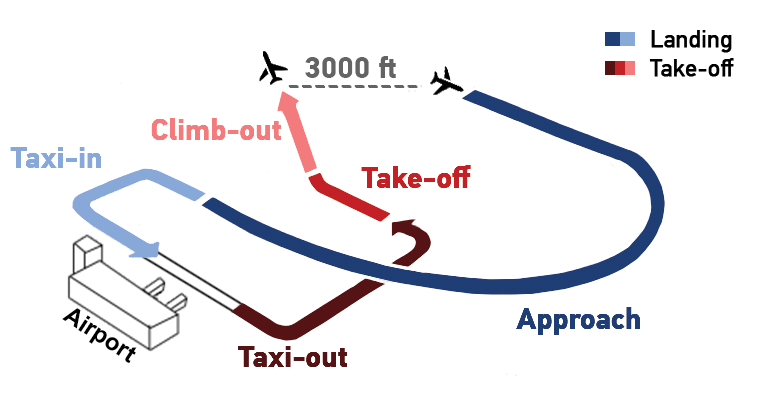 Home
Home
 Design point performance
Design point performance
 Aircraft Engine
Aircraft Engine
 Ramjet Engine
Ramjet Engine
 Hybrid Rocket Engine
Hybrid Rocket Engine
 Turboramjet Engine
Turboramjet Engine
 Supersonic 2-spool Engine
Supersonic 2-spool Engine
 Compressor Map
Compressor Map
 Emissions Calculation
Emissions Calculation
Welcome to the emissions calculator. You can use this section to calculate the emissions produced by aircraft engines in two main modes. Those modes are the LTO cycle and the cruise. The results are given in kg for the following pollutants: NOx, SOx, CO, HC, CO2. If you want to find more about the modes, click down below.
The Landing/Take-off (LTO) cycle, as defined by ICAO, contains all activities near the airport that take place below the altitude of 3000 feet (1000 m). This includes taxi-in and out, take-off, climb-out, and approach/landing.
‘Taxi-out’ or 'Idle' is the controlled movement of an aircraft on the ground, under its own power, between its parking area and the point of the runway from which its taking-off operations will occur. ‘Take-off’ is the phase of flight in which an aircraft moves from the runway to flying in the air. ‘Climb Out’ is the phase of flight during which the aircraft ascents to a predetermined cruising altitude after take-off. Although a single climb phase is typical, multiple-step climb phases may also occur. ‘Landing’ is the part of a flight when an aircraft returns to the ground up to the point at which taxi-in starts.
Cruise occurs between the climb and descent phases and is usually the longest part of a journey. It ends as the aircraft approaches its destination and the descent phase of the flight commences in preparation for landing. During the cruise phase, because of operational or air traffic control (ATC) reasons, aircraft may climb or descend from one flight level to a higher or lower flight level.